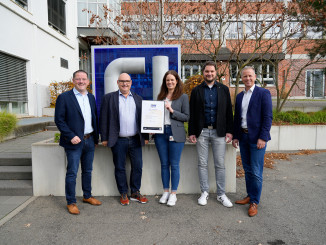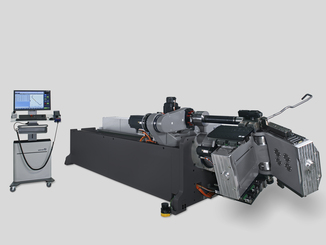
From small cars to large trucks: conductor rails can be found in a wide variety of electric vehicles. Different requirements, dimensions and geometries must be taken into account during production. The busbar machines from Wafios cover a wide range of products. One process step in production is stripping, which can be carried out either by laser or mechanically. If manufacturers are looking for a fast cycle time and cost-efficient production, mechanical stripping is the right choice.

© Wafios
Whether short or long, complex, with twist or without – Wafios busbar machines can be individually adapted to meet production requirements. The BMF series is particularly suitable for more compact busbars that are installed in vehicles with limited space, for example.
Like conventional bent parts, the conductor rails are manufactured using a 3D bending process. Thanks to the patented Wafios tool technology, very tight radii are possible with a thin profile thickness. In addition, the alignment of the conductor rail ends can be flexibly changed by twisting. At the same time, the patented rotating infeed, which is used in almost all Wafios wire bending machines, offers maximum production speed: during production, only the lighter component is rotated, not the bending head itself.
Looking for a busbar machine that can handle particularly long busbars with a large conductor cross-section? The Twister² 25 and Twister² 35 are the answer. Originally designed for tube bending, the Twister² was adapted for e-mobility. The result: a machine that can process conductor rail cross-sections of 300 mm² and lengths of up to 3000 mm.
The tools used with the rotary tensile bending process from the pipe bending sector are very gentle on the material and prevent surface deformation, for example. At the same time, sufficient bending moment is available to bend conductor rails with 300 mm² over both the long and short sides of the profile.

© Wafios
Automation solutions for customized conductor rails and optimal production processes
For the busbar bending machines, Wafios offers integrated automation solutions for additional or subsequent operations. These include the punching of various geometries, ultrasonic welding, the feeding and mounting of connection assemblies, the marking of the busbars and the position-oriented depositing on workpiece carriers or conveyor belts. This enables manufacturers to increase their productivity, improve quality and reduce costs per unit.
“Thanks to automation solutions such as EasyRobot, handling busbars is also no problem. The operation of the robot is fully integrated into the bending machine,” says Jörg Eisele, CEO at Wafios.
Mechanical vs. laser stripping
Stripping is an important step in the processing of busbars. After stripping, the surface must be free of any residue of the PA-12 material. Mechanical stripping ensures that all traces of the insulating material are completely removed. A small amount of the core material is also removed for this purpose. In contrast, the CO2 laser always leaves a layer in the micrometer range for physical reasons. This layer must then be removed with brushes in order to keep the contact resistance low.
The demand for mechanical stripping has continued to rise due to the high price pressure on the market. “Mechanical stripping is a cost-effective alternative to CO2 lasers. It helps to reduce stripping cycle times by 40 percent or more, which leads to a higher output of the entire machine system,” says Eisele.
Fully integrated and highly flexible
The stripping system of the BMF 60 and BMF 90 busbar machines offers great flexibility with seven axes and two milling units. The material is first stripped on the top and bottom, then rotated by 90° and then the side surfaces are processed. Depending on the connection situation of the conductor rail, the CNC stripping device can be used to produce any combination at the end of the conductor rail, for example only one stripped side, stripped top and bottom sides or all four sides.
The stripping device is integrated into the machine between the infeed and the cut. It is fully adjusted via the simple and intuitive Wafios WPS 3.2 EasyWay programming system.
Facts & Figures
Wafios develops, designs and manufactures sophisticated special machines for the wire and tube processing industry as well as for cold forming. The company is one of the leading suppliers in this field. Over 130 years of experience speak for quality and innovation. The product range comprises more than 130 machine types. Equipped with state-of-the-art software, artificial intelligence and IoT, Wafio’s machines optimize piece output and quality and improve the set-up process.
60 percent of customers come from the automotive and supplier industry, with a growing share in e-mobility. Other important sectors include mining, construction, electrical engineering, medical technology, household appliances, agriculture and the furniture industry. The export share is over 60 percent.
Today, Wafios is a group of companies with Wafios AG in Reutlingen as the parent company and several locations in Germany (Reutlingen, Marktredwitz, Wuppertal, Berlin, Simonswald), in France (Ecuelles), in Portugal (Maia), in America (Branford/USA, Mokena/USA, Querétaro/Mexico, São Paulo/Brazil) and in Asia (Shanghai/China, Zhangjiagang/China) to support customers locally.
Under the Connectavo brand, Wafios is expanding its core business and developing cross-industry software solutions for the maintenance of machinery, building technology, vehicle fleets and other technical equipment, for example.
Web:
www.wafios.de



